Travel
Indiana – Innovative Travel, Tourism, and Outdoor Recreation Case Study
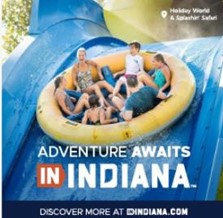
The below case study was developed through a NGA partnership with Oregon State University’s Center for the Outdoor Recreation Economy to research and assess the Travel, Tourism and Outdoor Recreation award program at the U.S. Economic Development Administration. Read the full report here.
Project Overview
Grant: Indiana Destination Marketing Campaign – “IN Indiana”
Grant recipient: Indiana Lt. Governor’s Office for Indiana Destination Development Corporation
Type of grant: State Tourism Grant
EDA funding: $5,582,552
Total project funding: $5,582,552
Current project status: Completed
(Source: Indiana Destination Development Corporation)
What is unique, innovative: Indiana Destination Development Corporation (IDDC) developed an extensive “IN Indiana” toolkit of resources available free of charge to businesses, small towns, big cities, and other state destinations. The IN Indiana campaign allows any stakeholder, no matter what their budget, to benefit from the tools.
The unique product is part of the IDDC’s open-source marketing campaign (available online at no cost to those who sign a license agreement) with no taglines. IN Indiana is the identifier. The entity creates their own unique “headline” to complement their existing marketing. The state provides the toolkits to help users find the fonts and colors necessary to kick-start a new brochure or website. Specially targeted IN Indiana design kits include: logos and brand guides, digital ad templates, print collateral templates, tradeshow collateral, social media templates, promotional items, and more.
Each resource is customizable for Indiana stakeholders, allowing them to personalize their marketing efforts while at the same time presenting a unified front and consistent template. The idea is to help Indiana function as a state united in its approach to spreading the word about the state’s assets and attractions. As an example, an Indiana organization that distributes a newsletter to its outreach list can use IDDC’s newsletter template with the IN Indiana masthead or headline and add their own subheads and stories as needed.
Another underlying concept is to help develop grassroots pride and ownership that, in turn, generates use of the tools — and a user can use any or all the available tools in the kit. At the launch event, the Governor pointed out that the campaign is meant to be flexible in a way that can be magnified far beyond just the state government’s efforts. The state is open to partnerships with other public agencies and private organizations based on the campaign’s brand.
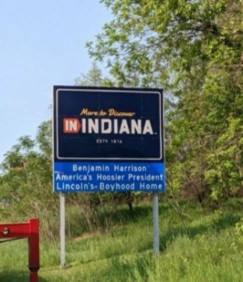
(Source: Indiana Destination Development Corporation)
Governor Holcomb partnered with IDDC and the Indiana Department of Transportation (INDOT) to create new IN Indiana interstate signage welcoming visitors to Indiana, or welcoming Hoosiers home. INDOT interstate entry signs reading “More to Discover IN Indiana” are located on 19 interstate routes and 57 non-interstate routes (Figure 12).
The new approach of providing culled photos, videos, and templates is being used to create a large body of knowledge about the state. The more it is used and shared, the bigger the megaphone becomes. This innovative and unique marketing effort is a comprehensive and compelling way to tell “the authentic Hoosier story” and a model for other states to replicate in telling their “authentic story.”
The ultimate target audience for the marketing campaign in terms of workforce and talent attraction is both visitors and college students. For this purpose, IDDC produced a photo and video library, as well as donut videos about the quality of life in the state. A donut video is a pair of short professionally produced video file that can be added to the beginning and end of any video or audio to brand it through repeated use. A video/audio donut is analogous to a print template, for instance. Using the templates, municipalities can fill in the middle section and send out messages as recruiting videos regarding what their city or town has to offer.
Takeaways on What’s Replicable: The unifying sort of messaging of IN Indiana — which can be adapted by anyone using the IN Indiana toolkit — is unique to Indiana, but the model is replicable in other states and locations. Being provided at no-cost to anyone who chooses to use them, the tools save time, effort, and especially money.
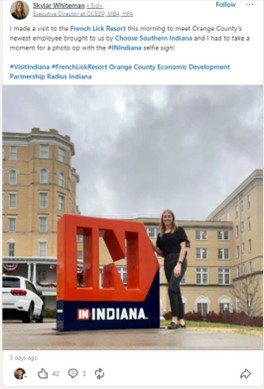
(Source: Indiana Destination Development Corporation)
The EDA funded project prompted the use of state general funds to provide local grants supporting the IN Indiana messaging. In order to make the IN Indiana messaging more sustainable in connecting local communities with the rest of the state, IDDC began funding IN Indiana Placemaking Activation grants in March 2024. These are matching grants of up to $25,000 to fund signage that showcases local communities using the IN Indiana identifier. The first group of IN Indiana grants that were awarded include a variety of locations from urban to rural settings, in both large and small communities, and in different regions of the state — Fort Wayne, the city of Madison, the towns of Danville and Lagro, the counties of DeKalb and Spencer, and others. These grants also represent state-local partnerships for fostering sustainable development. There is a shared-cost aspect in that the state is matching a municipality’s investment of say $25,000 with another $25,000 which helps make a project more do-able at the local level.
Additionally, EDA funds were used to purchase branded collateral and continue to build IN Indiana signs (Figure 13), which are physical assets that have been deployed around the state to be used in public areas such as special events, tourism destinations, airports, and conventions centers, acting as a photo opportunity or selfie station. These pieces will be periodically relocated and have been deployed as activations with the intention of displaying state pride, driving campaign awareness, and shifting state perception of Indiana.
Background on the Project
The Indiana Destination Development Corporation (IDDC) was formed by the Indiana Legislature in 2019 to promote Indiana as a great place for living, visiting, learning, and earning. The IDDC became incorporated on July 1, 2020. The previous Indiana Office of Tourism Development (IOTD) evolved into the new organization, creating a seamless experience for stakeholders and tourism partners. IDDC is dedicated to promoting, branding, and telling Indiana’s story to attract and retain talent, students, and visitors.
This TTOR state tourism grant from EDA was used to develop a cache of photos and videos and a marketing campaign to increase tourism to help Indiana recover economically from the pandemic. This is the first marketing/tourism campaign for the state. In the past, the state had not done much self-promotion; did not have a tourism/marketing campaign with good data and results; and never received much of a budget from the state for these types of marketing/tourism efforts. Since they had not had a large marketing presence, their expectations for the possibilities were low.
IDDC’s immediate goal for the EDA project was to create a brand for the state of Indiana and test it, and then to share that with the state legislature. They needed a unifying message for the state, and the goals for that were to:
- Attract more visitors to the state.
- Attract talent for existing businesses.
- Retain college graduates from the state’s schools.
Background: IN Indiana campaign, launched June 8, 2022
The IN Indiana Campaign provided partners with FREE tools and customizable collateral to help tell the Hoosier State’s story.
- The campaign’s resources are available free of charge to every Indiana stakeholder.
- Spanning graphic design elements, photography, branding tools and brand pillars, the IN Indiana campaign functions as an open- source messaging platform where voices from all over the state can come together and tell a bigger story than has ever been told.
- The IN Indiana design kit includes logos, brand guides, social media templates, print collateral templates, tradeshow collateral, promotional items, digital ad templates, and more.
- Each resource is fully customizable for all Indiana stakeholders, allowing them to personalize their marketing efforts while at the same time presenting a unified front to potential visitors, future residents and companies looking to do business in Indiana.
Visitors help local and regional economies through their daily and weekly spending in restaurants, hotels, and entertainment spots. Talent attraction, particularly in identified sectors, contributes to existing business vitality. And retaining graduates contributes to the talent pipelines, resulting in expansion and innovation.
The question was, what could be done to provide a taste of what it would be like to live and work in Indiana? It would need to be an initiative that would help strengthen state connections with businesses in the state.
Indiana isn’t well-known by those outside of the state who may not have a clue about what Indiana has to offer. For example, the multinational pharma corporation Eli Lilly, Notre Dame University, and Purdue University are recognizable, but many outside Indiana’s borders do not realize that these great institutions are located in Indiana. Indiana is using its new IN Indiana campaign to educate and build a body of knowledge regarding the assets it has to offer to residents and visitors.
The state paid an outside marketing agency, which was already under contract with existing state budget dollars, to help develop campaign products including a cache of available photos of state attractions. IDDC spent an initial $3.5 million of the EDA funding and then spent the remainder to apply the new branding and unified messaging.
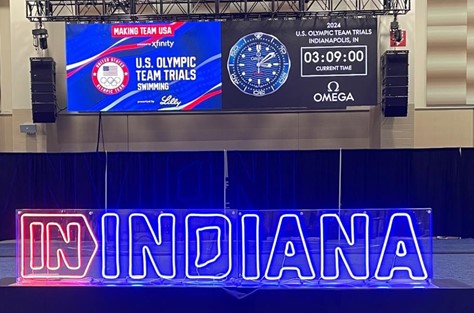
(Source: Indiana Destination Development Corporation)
IDDC has also been meeting with partners in all sectors of the state to adopt and use the IN Indiana campaign to further their marketing efforts and increase the campaign’s reach. They have met with organizations like the Studebaker Museum and the Mascot Hall of Fame to use the brand as well as the Indiana State Police Alliance and South Bend Cubs. They’ve also met with private companies such as Old 55 Distillery and the South Bend Chocolate Company. The driving ethos behind IN Indiana is also deeply rooted in empowerment. Their aim is to equip every stakeholder, irrespective of their scale or budget, with the requisite tools to narrate Indiana’s rich and authentic message. By providing an extensive array of complementary resources and collateral, they are ensuring that every town, city, and destination within our state has a platform to share their unique narrative.
Organizations also have the opportunity to partner with IDDC to share the costs of IN Indiana tourism and quality of life campaign. Options include:
- Traditional and digital paid marketing, where IDDC provides a 1:1 match (i.e. when the IN Indiana logo is featured), and monthly newsletters such as Festivals & Events and Things to Do.
- Quarterly and annual digital VisitIndiana.com advertising and email blasts.
Project Actors – State leaders, champions, stakeholders
This project has both the Governor and Lt. Governor as project champions. IDDC operates as a joint public-private agency, governed by a 7-member board appointed by Indiana Governor Eric Holcomb. Lt. Governor Suzanne Crouch serves as the chair of IDDC’s board.
On June 8, 2022, Governor Holcomb and Lt. Governor Crouch held a press conference (see quotes above) along with Elaine Bedel, Secretary & CEO of IDDC, to roll out the new IN Indiana marketing campaign to Indiana businesses and associations.
“In keeping with our great state’s spirit of innovation, this campaign gives tools and a voice to everyone, making Indiana stronger together. From Indiana’s shoreline to the hills in southern Indiana, there is something for everyone here IN Indiana.”
Indiana Governor Eric Holcomb
“From the smallest towns to the largest cities, the adaptable messaging of IN Indiana will instill pride…”
Lt. Governor Suzanne Crouch
Economic Benefits
The BEA’s Outdoor Recreation Satellite Account data, which is provided at the state-level, reported that outdoor recreation related value added in the state was relatively flat from before and during the pandemic. By 2021, value added exceeded the pre-pandemic levels realizing an annual growth rate of 27%. In 2022, value added continued to increase by 10%, which coincides with the beginning of the IN Indiana campaign’s effects were being realized. During the pandemic, outdoor recreation related employment fell by 13% and didn’t fully recover in total employment until 2022.
Indiana’s IN Indiana investment will serve as a model for other states interested in initiating a statewide innovative program to market the state and communities within the state to visitors, prospective employees, and prospective students, among others.
Economic impacts from the first year, during the pandemic: Once the first IN Indiana marketing campaign had been in force for six months in the spring and summer of 2022, IDDC had the impact measured based on data from the market research firm Longwoods International which has been conducting the longest ongoing study of domestic travelers in the U.S. Longwoods reported out on Indiana in late 2022 and early 2023. In short:
- The IDDC 2022 campaign motivated 864,000 additional trips by out-of-staters to Indiana that otherwise would not have materialized in the absence of advertising. (Incremental travel is typically made up of numerous individual trips, without a commitment to a specific end destination.)
- Using Indiana’s Travel USA® estimates of average visitor expenditures, it was estimated that the additional out-of-state visitors spent $102 million while in Indiana ($118 per person).
- This generated $11.22 million in additional tax revenue in Indiana from out of staters, and an out-of-state tax return on investment (ROI) of $6 for each ad dollar spent.
- Every $1 invested in the 2022 IDDC summer advertising campaign generated $50 in direct visitor spending and $6 in new taxes for the state.
IDDC is continuing to measure visitor spending month to month, which has continued to increase since before the campaign and data collection. In late 2022/early 2023, Indiana was second highest in the Midwest region on the month-over-month data point. The nationwide trend, at that time, was that people were still travelling less and spending less than they did before the pandemic.
Second year economic impacts: The spring/summer of 2023 marked the second year of IDDC’s IN Indiana advertising campaign. It was also the second year the marketing campaign had been measured by premier market research firms and travel and tourism industry leaders. In January 2024, Lt. Gov. Crouch and IDDC released the resulting study which shows the Indiana tourism industry’s growing momentum and continued positive economic impact including these highlights:
- Total Indiana visitor volume grew 4.5% in 2023 (compared to 2022) to 80.8 million person-trips.
- Visitor spending grew by 16% to $15.1 billion.
- Spending per visitor rose to $188.
- Tourism generated $2.8 billion in federal, state and local taxes.
- Indiana tourism supported 200,000 full-time and part-time jobs.
Continued research on ROI, image, and the halo effect: In February 2024, Lt. Gov. Crouch and IDDC released further analytics from the second (2023) IN Indiana summer advertising campaign revealing that Indiana had earned an ROI of $10 in new taxes for the state for every $1 spent by IDDC for its 2023 summer campaign; looking at the 2022 and 2023 campaigns combined, the 2-year ROI average was $7 of new tax revenue for the state. The IDDC Annual Report for 2023 noted a milestone that had been reached by the IN Indiana campaign: More than 650 individuals and organizations had joined the campaign and adopted the identifier to help promote the state.
In addition to measuring the campaign’s ROI, the study also examined the halo effect of the campaign and its impact on the state’s image. The IN Indiana campaign continued to positively impact travelers’ overall perceptions of the state. Some 51% of people who saw the 2023 promotion and visited Indiana “strongly agreed” that Indiana is a good place to live, compared to 27% who did not see the promotion and did not visit.
Other Benefits
Research on image, perception: The first campaign also changed the perception of what it is like to live in Indiana. Around 25% of a consumer awareness group had previously strongly agreed that Indiana is a good place to live. Among a group who saw the new marketing messages, 40% strongly agreed that Indiana would be a great place to live or start a business.
With the increased focus on Indiana as a destination, an outcome of the EDA TTOR funding has been the creation of a program using state dollars to award Indiana Destination Development (IDD) project grants, as IDDC began awarding grants for IDD projects based on the IN Indiana slogan. These are matching grants between $50,000 and $250,000 to fund public high-impact projects that will enhance existing attractions to help boost Indiana’s capacity for attracting visitors and providing tourism experiences. As examples, the Evansville Museum of Arts, History & Science and the Indiana Military Museum were recipients.
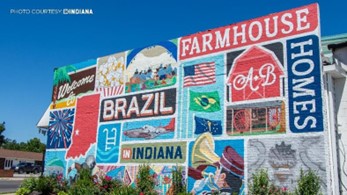
(Source: Indiana Destination Development Corporation)
IN Indiana public murals and artwork: In working to tell Indiana’s story, IDDC has also partnered with nonprofits, especially in the arts. In late 2023, IDDC announced the recipients of IN Indiana Public Arts grants which showcase Indiana’s diversity, charm, character, and rich history. These are non-matching grant projects of up to $10,000. The public murals created in partnership with local artists included the IN Indiana campaign logo somewhere on the artwork (see Figure 15).
The IN Indiana campaign, in its journey of success, has been spotlighted at various significant press events. IDDC was able to host two national media trips with Geiger PR. One in the northern part of the state, and one in the southern part of the state. IDDC also enlisted the help of Turner PR to actively pitch Indiana stories to maximize the perception of the state (Figure 16).
IDDC also built on the publicity of the 2024 Solar Eclipse, where a large portion of the state was in the path of totality for the eclipse, to provide solar glasses to the public in key markets. These glasses were handed out for free at public events and made available in public rest stops along major highways. Additionally, IDDC ran a campaign to promote the total eclipse in Indiana, driving traffic to the webpage InIndiana.com/Eclipse2024, which contains helpful information and resources for visitors.
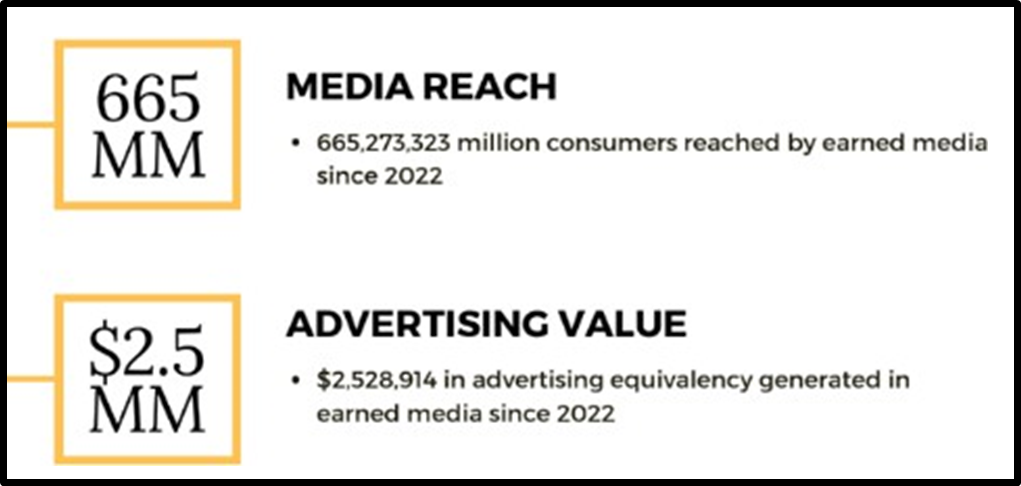
(Source: Indiana Destination Development Corporation)
IDDC is now doing a study to examine all the potential destination attractions and assets throughout the state. They are also doing a gap analysis to determine what’s missing. In the future, more incentive dollars may be offered to purposely build out certain identified assets and attractions.
Partnerships for diverse employment and student retention: Indiana has a relatively low unemployment rate. Some of the new IDDC programs have already helped to attract needed talent to the state. IDDC is targeting talent and student retention through intern experiences; collaboration with colleges and universities; and videos available to businesses and municipalities to promote their jobs and quality of life.
IDDC is working with the seven public and the 29 private colleges/universities in the state to retain graduates and to promote a future for a diverse employment population. This also includes collaborating with the Black Chamber of Commerce, the Asian American Alliance, and other cultural and business groups. Being conscious of DEI principles in trying to reach a more diverse audience, they are presenting more diversity in their marketing visuals showcasing the state.
The state’s IDDC recently partnered with leaders in the city of Fort Wayne, Indiana, to invite interns working at area businesses to participate in networking and social events; 200 interns signed up for the program. The resulting outcome for the interns was creating their own social network and learning about the community. Based on before-and-after surveys asking whether the interns would consider working in Fort Wayne, they received very positive feedback. The sessions averaged 50 attendees with a high turnout of 100 attendees. Next year, the city plans to do the same type of event on its own. In terms of the feedback: One intern from out-of-state on his second internship, who was offered a job that he plans to accept, responded that having had this experience made him decide to stay in Indiana.
Indiana Legislature Outcome: An ultimate benefit was IDDC’s ability to leverage the EDA TTOR funds to gain an increased budget of $20 million (a 5-fold budget increase relative to what IDDC inherited when it was formed in 2020). Legislators found the ROI of the IN Indiana campaign and the positive change in perception for those who visited Indiana to be compelling evidence regarding the value of the new IN Indiana messaging. As noted earlier, in mid-2020, the new IDDC had inherited a small budget of $4 million from the earlier Indiana Office of Tourism Development. Based on the successful results of the EDA-funded project that began in late 2021, IDDC had almost $5.6 million in funds coming in from EDA. If IDDC had not received this EDA grant, they would not have been able to show the positive results to the state legislators to get an increased allocation of $20 million for their state annual budget. Significantly, the EDA grant allowed IDDC to show what it could do to attract and retain talent, graduates and visitors. The new $20 million may now help accomplish even more toward helping Indiana local governments with visitor attraction such as through expanded Indiana Destination Development projects.
Challenges
A challenge of the moment is how to encourage more widespread adoption of the toolkits. By developing the toolkits and resources and providing them free-of-charge to encourage their adoption, there remains the challenge of implementation. Everyone who becomes knowledgeable of the IN Indiana open-source marketing campaign is positive and open to its use, but it’s often difficult to give the implementation the immediate attention that it needs.
To help control for retaining a consistent brand for the state while marketing unique characteristics of places within the state, IDDC requires users to sign a licensing agreement when they download the marketing campaign’s templates and other resources. As examples, IDDC has online Terms of Service Agreements for the use of photos, videos, donut videos, sizzle reels, Hoosier by Choice videos, Home Again videos, and the Top 5 videos.
Key Findings and Lessons Learned
The state’s findings: IN Indiana is an identifier for the state. Any entity can create its own headline to go with the identifier by using the toolkit. The state has found that there are a variety of creative ways the new marketing templates are being used. Users are pairing the templates with their own slogans to help promote Indiana attractions. For example:
- Cities and towns are using it to market upcoming festivals and cultural events, and to attract visitors to special locations. One example: Visit Madison IN Indiana.
- Businesses are adding their own headlines such as one created for a utility company within the State: Your Energy. Your Future. IN Indiana.
- Individual users are both creating their own headlines, and using the templates more and more to discover all the different headlines and sub-headlines that are already available online.
International, National & State Awards for IN Indiana: Since the new IN Indiana messaging was first introduced on June 8, 2022, it has been recognized with nine awards: Gold Addy Award and Addy’s Judge’s Choice Award from the American Advertising Federation recognizing the creative spirit of excellence in advertising; two Platinum MarCom Awards and a Gold MarCom Award for video campaign – with MarCom awards honoring excellence in marketing and communication; two Platinum Hermes Awards which are awards for creativity (categories: Integrated Marketing Materials, Advertising Campaign); Public Relations Society of America (PRSA) Hoosier Chapter Pinnacle Award; and a Mercury Award finalist in the U.S. Travel Association’s Educational Seminar for Tourism Organizations (ESTO), recognizing excellence in destination marketing on the state level.
Lessons Learned: Promoting the state of Indiana produced very positive returns, both a positive financial benefit as well as a positive perception impact. IDDC knows that the more broadly you can tell your story, the more consumers learn about the state, the more visitors are attracted. Funding is the key. It is important to demonstrate the value of promoting the state on a small scale to gain the opportunity to expand into new markets.
Producing a messaging campaign (IN Indiana) that is universally applicable and accepted is key to leveraging the marketing efforts of the entire state. The IN Indiana campaign has resulted in approximately 1,700 downloads of the IN Indiana campaign toolkits and more than 1,200 activations. Examples include product packaging, outdoor art, and municipal signage.
In highlighting the state’s regional market focus, IDDC’s Bedel acknowledged that a campaign can only have so much impact, depending on the funding behind it. “We’re going to continue to measure the return of our marketing campaigns. With that information in hand, we will work with the legislators to increase our budget to allow our messaging to reach a larger portion of the population. Our goal is to expand beyond our geographic region to attract visitors from around the nation and the world.”
Time Factors, Any other Guidance Necessary for Replication
The first “IN Indiana” marketing campaign took place in the spring and summer of 2022, running for about 6 months through to the end of August 2022. At that point, the market research firm measured the 2022 results which were released in early 2023. The return on investment (ROI) was $6 in new taxes created for each $1 spent. Based on those results, the 2023 legislative session provided a larger annual budget of $20 million for FY24 and FY25. To validate the 2022 findings, IDDC elected to spend approximately the same budget in the same markets for the 2023 spring/summer campaign. The ROI was $10 of new taxes created for every $1 spent. With the increased FY24 budget, IDDC plans to spend $9 million in the spring and summer campaign of 2024. The ROI will be measured and available in late 2024.
Read the full report on Innovative Travel, Tourism, and Outdoor Recreation Awards, or additional case studies from: Colorado, Hawai‘i, Maine, North Dakota, and West Virginia.
Disclaimer: This document was prepared by the National Governors Association using Federal funds under award ED22HDQ3070131 from the Economic Development Administration, U.S. Department of Commerce. The statements, findings, conclusions, and recommendations are those of the author(s) and do not necessarily reflect the views of the Economic Development Administration or the U.S. Department of Commerce.










